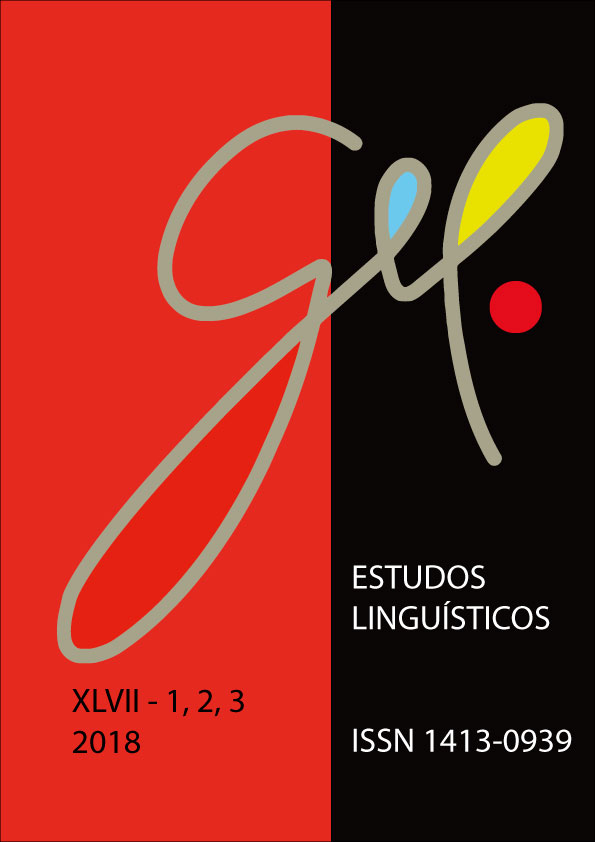Telegramas e ‘fala telegráfica’
DOI:
https://doi.org/10.21165/el.v47i2.1936Palavras-chave:
agramatismo, telegramas, estilo reduzidoResumo
O objetivo deste estudo é criar um paralelo com Tesak e Dittmann (1991), comprovando que telegramas apresentam uma estrutura própria que não pode ser diretamente comparada com a estrutura da fala de sujeitos afásicos com agramatismo. Foram analisados 70 telegramas obtidos através de um experimento e 76 enunciados de um sujeito afásico com agramatismo, coletados numa situação de conversa informal. Neste estudo, são feitas quatro principais diferenciações entre os dois registros: eles diferem no tocante (i) às razões para a emergência do estilo telegráfico e da fala agramática, (ii) ao volume de material linguístico, (iii) à finitude dos verbos empregados e (iv) à ordem das palavras. A fala agramática é examinada a partir da Neurolinguística de orientação enunciativo-discursiva e da Teoria da Adaptação.Downloads
Referências
ABREU, A. S. Gramática mínima: para o domínio da língua padrão. Cotia: Ateliê Editorial, 2003.
BAKHTIN, M. O enunciado, a unidade da comunicação verbal. In: BAKHTIN, M. Estética da criação verbal. São Paulo: Martins Fontes, 1997. p. 289-327.
BELFORD, E. de M. Topicalização de objetos e deslocamento de sujeitos na fala carioca: um estudo sociolingüístico. 2006. 91 p. Dissertação (Mestrado em Linguística) – Faculdade de Letras, Universidade Federal do Rio de Janeiro, Rio de Janeiro, 2006.
COUDRY, M. I. H. Linguagem e afasia: uma abordagem discursiva da neurolinguística. Caderno de Estudos Linguísticos, v. 42, p. 99-130, 2002.
COUDRY, M. I. H. et al. (Orgs.). Caminhos da Neurolinguística Discursiva: teorização e práticas com a linguagem. Campinas: Mercado de Letras, 2010.
HAARMANN, H.; KOLK, H. A computer model of the temporal course of agrammatic sentence understanding: the effects of variation in severity and sentence complexity. Cognitive Science, v. 15, p. 49-87, 1991.
HEESCHEN, C.; KOLK, H. Adaptation bei Aphatischen Störungen. Zeitschrift für Literatur-wissenschaft und Linguistik, v. 18, n. 69, p. 41-54, 1988a.
HEESCHEN, C.; KOLK, H. Agrammatism and Paragrammatism. Aphasiology, v. 2, p. 299-302, 1988b.
HOFSTEDE, B. T. M. Agrammatic speech in Broca’s aphasia: strategic choice for the elliptical register. 1992. 121 f. Tese (Doutorado em Linguística) – Radboud Universiteit Nijmegen, Países Baixos, 1992.
JACOBS, J. The dimensions of topic-comment. Linguistics, v. 39, p. 641-681, 2001.
KLEPPA, L.-A. Estruturas de tópico-comentário na fala reduzida de um sujeito afásico. Revista Estudos Linguísticos, v. 43, n. 2, p. 926-939, 2014.
KOLK, H. A Time-Based Approach to Agrammatic Production. Brain and Language, v. 50, p. 282-303, 1995.
KOLK, H. Syntactic impairment is the bottle-neck to communication in nonfluent aphasia. Aphasiology, v. 15, p. 381-385, 2001a.
KOLK, H. Does agrammatic speech constitute a regression to child language? A three-way comparison between agrammatic, child and normal ellipsis. Brain and Language, v. 77, n. 3, p. 340-351, 2001b.
KOLK, H. How Language Adapts to the Brain: An Analysis of Agrammatic Aphasia. In: PROGOVAC, L.; PAESANI, K.; CASIELLES, E.; BARTON, E. (Orgs.). The Syntax of Nonsententials. Multidisciplinary perspectives. Linguistik Aktuell, v. 93, p. 29-258, 2006.
KOLK, H.; HEESCHEN, C. Review. Adaptation symptoms and impairment symptoms in Broca's aphasia. Aphasiology, v. 4, p. 221-231, 1990.
KOLK, H.; HEESCHEN, C. Agrammatism, Paragrammatism and the Management of Language. Language and Cognitive Processes, v. 7, n. 2, p. 89-129, 1992.
KOLK, H.; HEILING, G.; KEYSER, A. Agrammatism in Dutch: Two Case Studies. In: MENN, L.; OBLER, L. (Orgs.). Agrammatic Aphasia: A Cross-language Narrative Sourcebook. John Benjamins Publishing Company: Amsterdam/ Philadelphia, 1990. p. 179-280.
KOLK, H.; VAN GRUNSVEN, M. J. F. Agrammatism as a variable phenomenon. Cognitive Neuropsychology, v. 2, p. 347-384, 1985.
MASLOVA, E.; BERNINI, G. Sentence topics in the languages of Europe and beyond. In: BERNINI, G.; SCHWARTZ, M. L. (Eds.). Pragmatic organization of discourse in the languages of Europe. Berlin, New York: Mouton de Gruyter, 2006. p. 67-120.
MORATO, E. M. (Org.). Sobre as afasias e os afásicos. Campinas: Editora da Unicamp, 2002.
MORATO, E. M. Introdução. In: MORATO, E. M. (Org.). A semiologia das afasias: perspectivas linguísticas. São Paulo: Cortez, 2010, p. 9-21.
NOVAES PINTO, R. do C. Agramatismo: uma contribuição para o estudo do processamento normal de linguagem. 1992. 173 f. Dissertação (Mestrado em Linguística) – Instituto de Estudos da Linguagem, Universidade Estadual de Campinas, Campinas, 1992.
NOVAES PINTO, R. do C. A adoção de conceitos bakhtinianos para a análise de linguagem de sujeitos afásicos. Lingua(gem), v. 1, n. 1, p. 111-147, 2004.
NOVAES PINTO, R. do C. Cérebro, linguagem e funcionamento cognitivo na perspectiva sócio-histórico-cultural: inferências a partir do estudo das afasias. Letras de Hoje, v. 47, n. 1, p. 55-64, 2012.
PERINI, M. A. Gramática Descritiva do Português. São Paulo: Ática, 1995.
PONTES, E. O tópico no português do Brasil. Campinas: Editora Pontes, 1987.
STARK, J. A.; DRESSLER, W. U. Agrammatism in German: Two Case Studies. In: MENN, L.; OBLER, L. (Eds.). Agrammatic Aphasia: A Cross-language Narrative Sourcebook. John Benjamins Publishing Company: Amsterdam/ Philadelphia, 1990. p. 281-442.
TESAK, J. Dutch telegraphese. Linguistics, v. 32, p. 325-344, 1994.
TESAK, J.; DITTMANN, J. Telegraphic style in normals and aphasics. Linguistics, v. 29, p. 1111-1137, 1991.
TESAK, J.; NIEMI, J. Telegraphese and agrammatism: a cross-linguistic study. Aphasiology, v. 11, p. 145-157, 1997.
VERSLUIS, C.; KLEPPA, L.-A. The use of interactive structures as communicative strategy in Dutch and Portuguese aphasic speakers. In: PASCUAL, E.; SANDLER, S. (Eds.). The conversation frame: forms and functions of fictive interaction. Amsterdam/Philadelphia: John Benjamins Publishing Company, 2016. p. 323-342.



